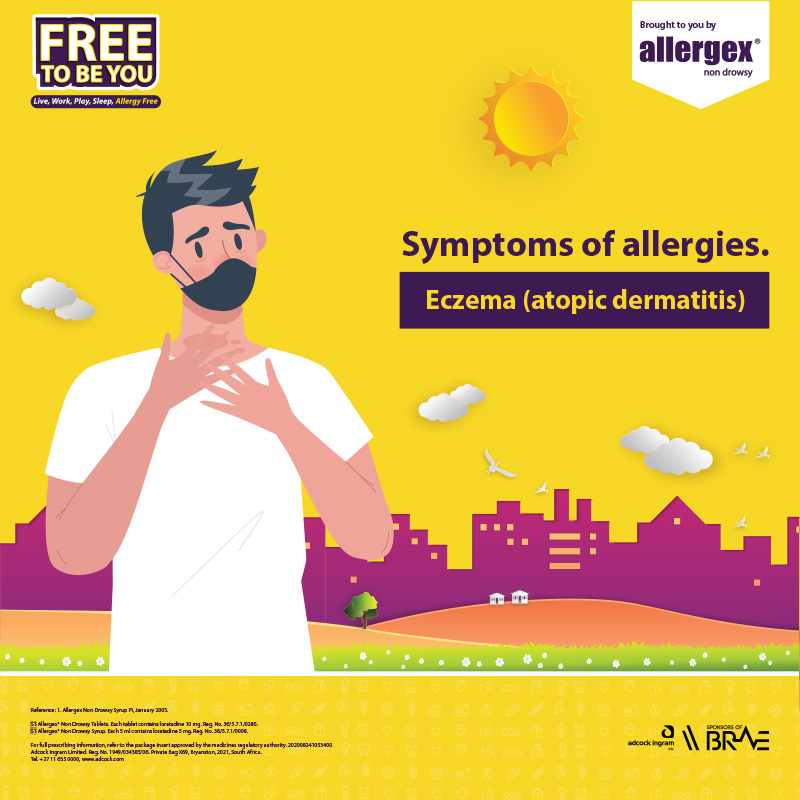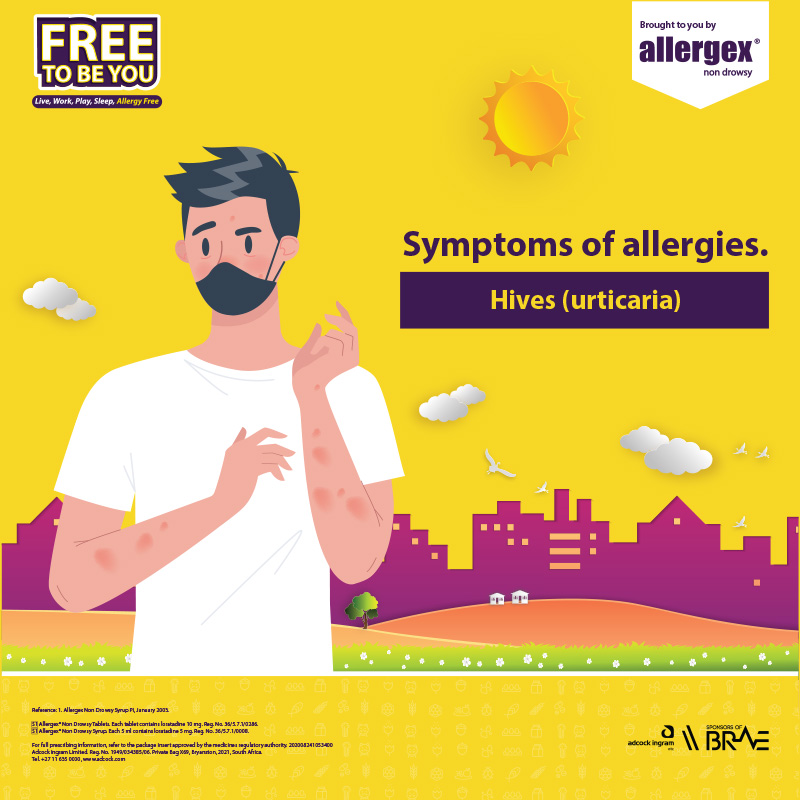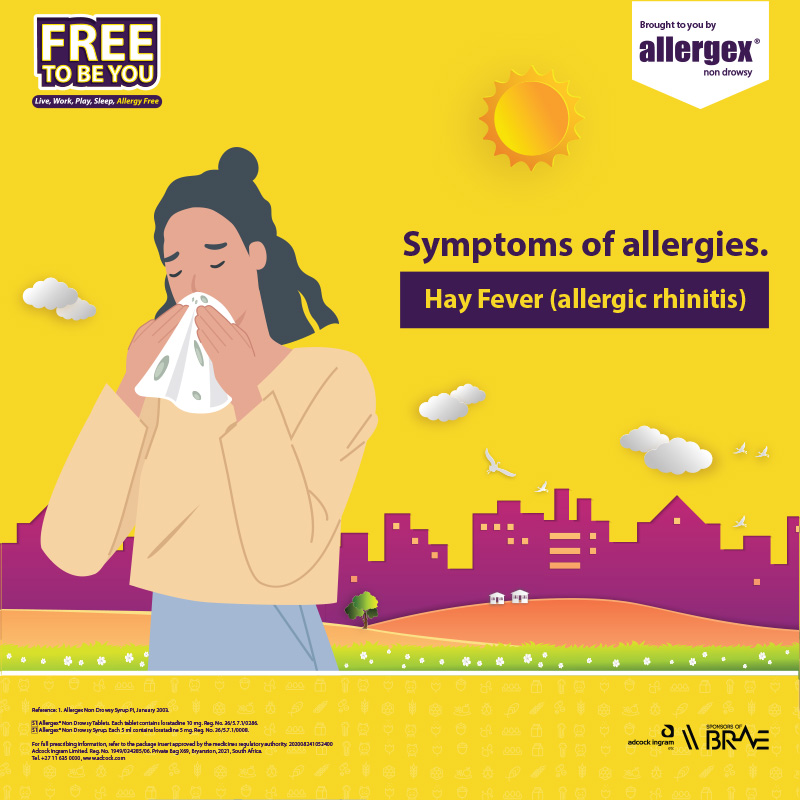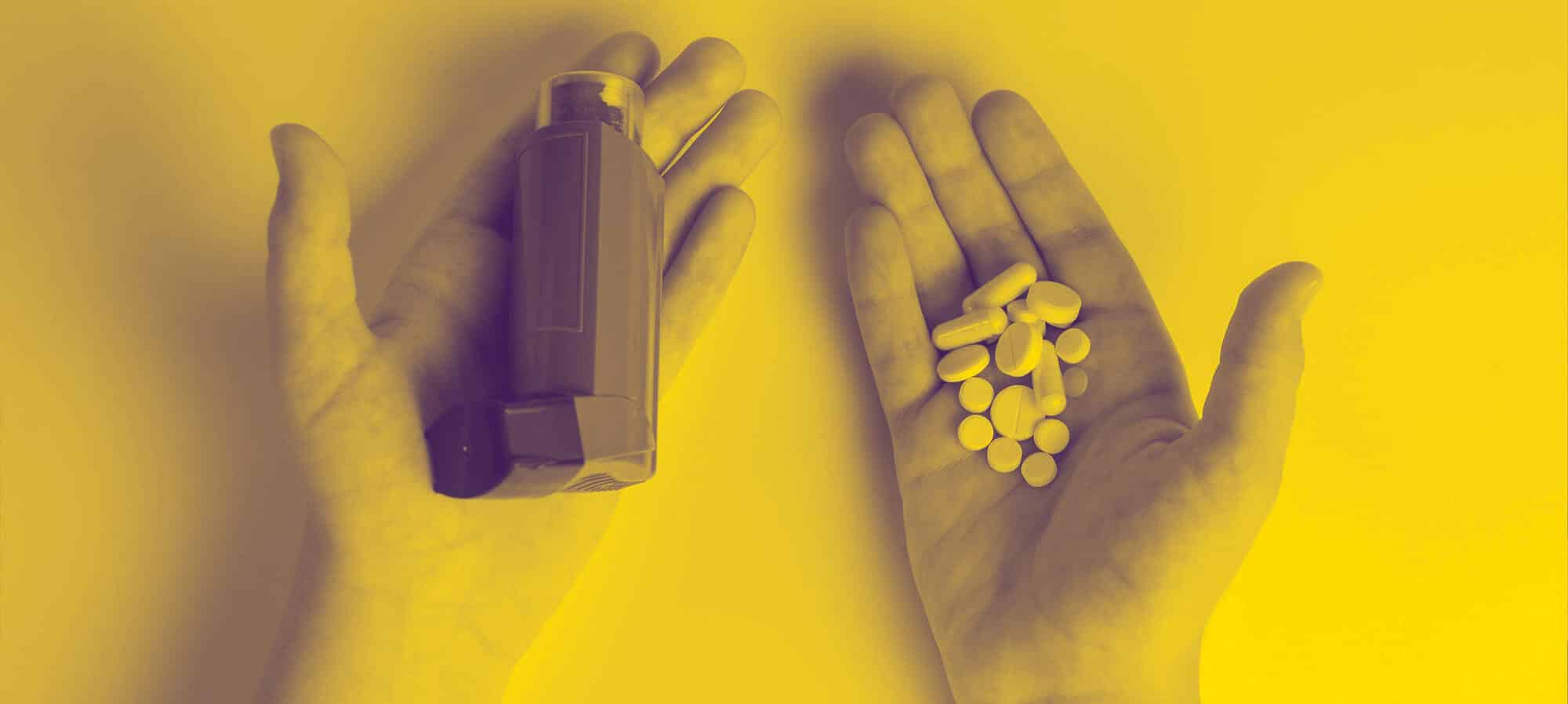
Eczema (atopic dermatitis), which is often found with other allergies (asthma and allergic rhinitis). Your skin would be very dry and itchy. Any area of the body can be involved but eczema usually occurs behind the knees and elbows and on the face.

Hives (urticaria) is a skin reaction (often to medicine or food that you are allergic to) that appears as raised red welts which are extremely itchy and there is sometimes swelling of the lips, face, hands and feet.

Hay fever (also known as allergic rhinitis) is the most common of the allergies and the nose, eyes, sinuses and throat are usually involved. The most common symptoms of hay fever are a runny nose and a post nasal drip (causing you to clear your throat often), a stuffy or blocked nose, sneezing (lots of it) and itchy nose, eyes, ears and throat.
The Allergy Guide
- What Are Allergies
- Symptoms of Allergies
- Causes Of Allergies
- Diagnosing Allergies
- Treatment Of Allergies
Allergies are a very common topic of conversation in our lives – they are so common that they have been described as the ‘epidemic of the 21st century’ and the prevalence of allergies has doubled over the last 20 years.1
The earliest mention of allergies is that of King Menses of Egypt, who was killed by the sting of a wasp at some time between 3640 and 3300 BC. Another report from ancient history is that of Britannicus, the son of the Roman Emperor Claudius. He was allergic to horses and ‘would develop a rash and his eyes swelled to the extent that he could not see where he was going’.1
An allergy is an abnormal reaction of your immune system to a substance, which is called an allergen, which you eat, inhale or touch. Non-allergic people can usually tolerate this substance,2 but if you are allergic to something, your immune system reacts to it as if it were a foreign body and tries to destroy it.3 This is when the body reacts by releasing chemicals like histamine, and these cause the symptoms of the allergy.
Allergy-producing substances are called ‘allergens’ and people who are prone to allergies are called ‘allergic’.4 The most common allergic diseases include allergic rhinitis (hay fever), allergic conjunctivitis (eye allergies) allergic asthma and food allergies.4
A common scene can help explain allergies:4
A few months after the new cat arrives in the house, dad begins to have itchy eyes and episodes of sneezing. One of the three children develops coughing and wheezing. The mom and the other two children experience no reaction at all even though the cat is there. How can this occur? The dad and the one child have become sensitized and have an allergic reaction to the cat while the mom and the other two children are not allergic to the cat and so are not affected.
Parts of the body that are commonly affected by allergies include the eyes, nose, lungs, skin and gastrointestinal tract (stomach).4

Histamine causes most of the allergic symptoms that occur during an allergic reaction. It causes small blood vessels to expand and the skin around these vessels to become red and swollen. Histamine also affects the nerves in the skin causing itchiness and it increases the amount of mucous produced in your nose lining which gives you a runny nose as well as itching and a burning sensation.5Histamine also causes tightening of the muscles in the airways and blood vessel walls.3
Allergic reactions can occur in the stomach or digestive system, skin, sinuses, airways, eyes and nasal passages.3
Hay fever (also known as allergic rhinitis) is the most common of the allergies and the nose, eyes, sinuses and throat are usually involved. The most common symptoms of hay fever are a runny nose and a post nasal drip (causing you to clear your throat often), a stuffy or blocked nose, sneezing (lots of it) and itchy nose, eyes, ears and throat.4
Asthma is caused by the airways becoming inflamed and hyper-reactive resulting in reversible narrowing of the airways and causing shortness of breath, wheezing, coughing and tightness in the chest.4
Allergic eyes or conjunctivitis have the following symptoms – redness under the lids and redness of the eye, watery and itchy eyes, swelling of the eyelids.4
Skin allergies include:
• Eczema (atopic dermatitis), which is often found with other allergies (asthma and allergic rhinitis). Your skin would be very dry and itchy. Any area of the body can be involved but eczema usually occurs behind the knees and elbows and on the face.4
• Hives (urticaria) is a skin reaction (often to medicine or food that you are allergic to) that appears as raised red welts which are extremely itchy and there is sometimes swelling of the lips, face, hands and feet.4
• Anaphylaxis is the most severe and serious type of allergic reaction. This type of reaction is life threatening with various parts of the body being affected. The areas most affected are the skin, breathing, stomach, heart and blood vessels and the nervous system. A reaction can happen in minutes or hours after exposure to the allergen and must be treated as a medical emergency.3

The substance responsible for causing an allergy is called an allergen.6
Allergens can either be seasonal, occurring at a specific time of the year or they can be perennial meaning that they can cause symptoms all year around. Allergens can be found indoors and outdoors.6
Indoor allergens:
- The most important of the indoor allergens is the house dust mite,7 which lives in nests in the carpets, in bedding and upholstered furniture. The house dust mite is one of the main causes of perennial rhinitis or hay fever and of asthma.6 In the 70’s in South Africa a researcher discovered that over 65 % of children living in Cape Town were sensitive to the house dust mite and that the more humid the area, the more common the house dust mite.7
- Pets can be another indoor allergen or cause of an allergic reaction in some people. Pet dander is made up of the dry scales of skin that we all shed but in pets there is a protein in the scales of skin, which many people become allergic to. The same protein is also found in pet saliva and urine.6Cat allergens are very sticky and can be found on clothing, soft furnishings and even walls. They are very small and can remain in the air for a long time. If you are allergic to cats you will get an allergic reaction very soon after entering a room that they have been in because the allergen can also be inhaled.8 Other pets that can cause allergies are dogs, hamsters, rabbits, budgies, parrots and canaries.7
- Another common indoor allergen in South Africa is the cockroach. There are 3 different types of cockroach that South Africans can be allergic to.7
- Seasonal allergic rhinitis or hay fever is usually caused by outdoor allergens and affects millions of people worldwide.9 Outdoor allergens tend to be more seasonal and include pollens from grass, trees, weeds and some moulds.6
- Pollen are tiny grains needed to fertilize many kinds of plants. Pollen from plants with colourful flowers, like roses, usually do not cause allergies. These plants rely on insects to transport the pollen for fertilization. On the other hand, many plants have flowers which produce powdery pollen that is easily spread by wind. These are the culprits causing allergy symptoms.9
- Moulds are tiny fungi related to mushrooms but without stems, roots or leaves. Moulds can be almost anywhere, including soil, plants and rotting wood. Their spores float in the air, much like pollen. Outdoor mould spores begin to increase as temperatures rise in the spring.9

Many people with untreated allergy symptoms aren’t aware of how much better they can feel once their symptoms are properly diagnosed and managed.
If you are troubled by any of these nagging symptoms, ask your doctor if you have an allergy:10
• Itchy eyes, nose and throat
• Nasal congestion or runny nose
• Watery eyes
• Hives, itchiness or other skin conditions
• Abdominal pain or diarrhoea after eating certain foods
• Severe reactions to insect stings
A number of other conditions have the same symptoms as allergies and it is therefore sometimes difficult to diagnose an allergy.
A starting point is to make an appointment to see your doctor who will then take a family history and do a physical examination.2
Allergy tests are the best way to find out if you have an allergy and exactly what it is that you are allergic to. Your doctor may do any of the following tests:
• Blood tests
• Complete blood count – you doctor will take a sample of your blood and send it off to the laboratory who will test your white blood count. If you have a higher than normal blood count, this means that your body is trying to fight off a foreign invader and this could be an allergen.2
• RAST (radio-allergosorbent test) – this test measures the amount of antibodies in your blood once you have been exposed to the allergen. It is a reliable test for allergens that you breathe in and for food allergies.2
• Skin tests
• Skin prick or scratch test – a series of different allergens are placed on your skin which the doctor then scratches or pricks. If you are allergic to the substance, you will experience a little hive or swelling at the site of the prick after about 15 – 20 minutes. This is used for allergens that you breathe in, insect allergies, food and medicine allergies.2, 10

The treatment for an allergy depends on the allergen which is causing the allergic reaction and the type of reaction. In some cases the best treatment is to avoid the allergen and then the allergic reaction will not occur – but this is not always possible.11
Medical treatment for allergies helps to ease and treat the annoying symptoms like congestion and a runny nose.12
Antihistamines have been used for years to treat allergy symptoms and are available as pills, liquid, nasal sprays, creams and eye drops. When you have an allergic reaction, your body releases a chemical called histamine which causes the allergy symptoms (redness, swelling, itching and an increase in secretions causing things like a runny nose). An antihistamine blocks this chemical, preventing it from causing these allergy symptoms.12 You can get an antihistamine from your pharmacy.
Decongestants are often prescribed with an antihistamine for allergies and they relieve congestion or a blocked nose which is often caused by hay fever, a dust allergy or a pet allergy. Decongestants can be taken as pills or capsules, nasal sprays or liquids, but should not be used for a long time.11 They work by shrinking swollen tissue in the nose and blood vessels, relieving the symptoms of nasal swelling & congestion (causing the blocked nose), as well as reducing a runny nose and redness. Decongestants are available from your pharmacy without a prescription. Steroid sprays also act on the lining of the nose and airways, and suppress inflammation causing congestion.11
Leukotriene receptor antagonists are a newer treatment consisting of tablets that you take which block leukotrienes that are substances released during an allergic attack causing airways to become inflamed or swollen. They are used to treat asthma and are often used with a steroid. A doctor’s prescription is needed for this medication.11
Bronchodilators are used to control the symptoms of asthma and are inhaled for quick relief during an asthma attack. They relax the muscles that tighten around the airways which rapidly open letting more air in and out of the lungs so that breathing is easier.12
Immunotherapy or desensitisation is sometimes recommended by a doctor for a small number of people with really bad hay fever and who are unable to control their allergy attacks. This treatment (allergy shots) expose you to gradually increasing levels of the offending allergen which causes your allergy, to help build your immune system against the allergens.12


